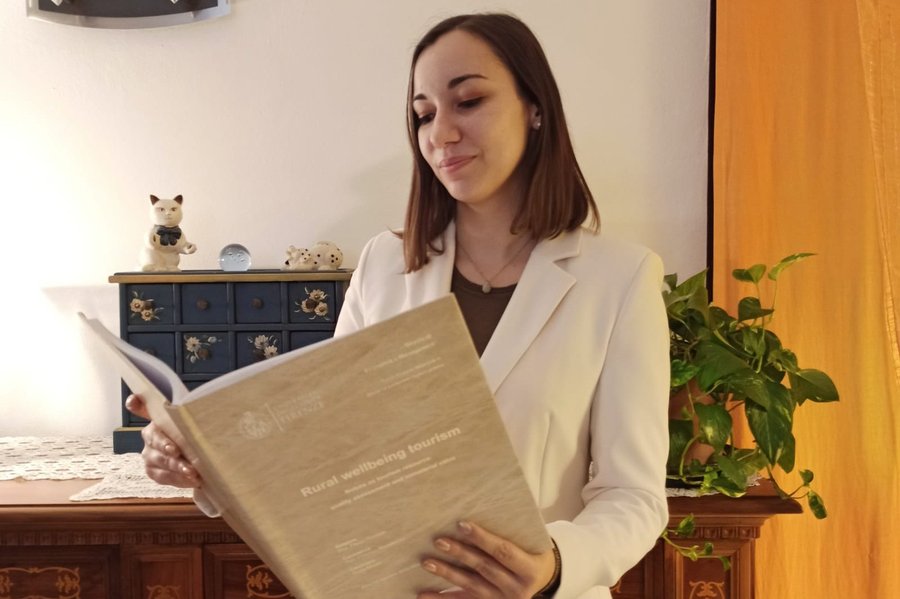Is tourism able to provide natural and human well-being at the same time?
The complex question in the title “Is tourism able to provide natural and human well-being at the same time?” was asked by Giulia Musso, a student of the University of Florence, in her master’s thesis on “Design of sustainable tourism systems”. She graduated and received the recognition award by Sistur (the Italian academic society which carries out research in tourism sciences) at the end of 2021. In a difficult year for tourism and well-being due to the Covid pandemic, EUniWell has been interested in the topic, since analysing tourism in the context of well-being can reveal strong signals for the future and for global recovery.
Coming back to the research, we must first ask the question: What is well-being? “Well-being is most commonly used in philosophy to describe what is non-instrumentally or ultimately good for a person.” (Carlisle et al., 2009). Nevertheless, in Musso’s thesis, this concept is understood in its widest meaning, including socio-economic well-being of the residents, psychophysical well-being of the tourists as well as environmental protection.
Once well-being is so broadly defined, there are notable relations between environment, residents and tourism: a safe environment can positively affect the local lifestyle and the tourism quality of a destination. It is clear now that not all the types of tourism are suitable in achieving well-being, certainly not mass tourism. On the other side of the spectrum, there is a specific product which allows for sustainable development, involving the local society and placing the tourists’ well-being first: namely, “rural well-being tourism”.
Rural areas and cultures need to be developed and they can provide physical and spiritual well-being to tourists, with the improvement of different components, such as relationships, optimism and self-esteem. Nature provides some important non-material benefits to people; the connection with nature is able to improve mood and happiness, to reduce stress and to restore cognitive abilities (Cheryl Willis, 2015). Landscapes with their aesthetic and other natural features can give pleasure and, consequently, enhance tourism satisfaction.
The main goals of rural well-being tourism are:
- To feel better;
- To slow ageing effects;
- To manage stress;
- To escape from busy everyday life;
- To achieve physical rest and a sense of comfort.
This first part gives the answer to the starting question: Effectively, it is possible for tourism to promote sustainability and well-being at the same time.
The second step of the research is about the assessment of the well-being and the tourism quality of a rural area. To achieve this goal, geo-referenced data was analysed by using GIS (Geographic Information System) and specific rural areas were examined.
The evaluation of the tourism quality of a rural destination begins with the real estate prices, which are a good indicator of the environmental value assigned by the market. Ona a more detailed level, statistical analysis uses the property prices of a specific area as an independent variable and reviews the relations with tourism variables (e.g. the number of accommodation facilities in the same area), service variables (e.g. the number of shops) and environmental variables (e.g. the change of carbon content in the soil over time).
Thanks to this method, it is possible to understand what actions are needed in a specific area to guarantee overall well-being. For example, within the “Langhe, Roero and Monferrato” area, there is a shortage of accommodation facilities in Monferrato, resulting in an underdeveloped territory from a tourism point of view. These results are essential to achieve well-being, because:
- Tourism enterprises need to know that there is space to increase the receptivity, improving the local economic development and the lifestyle of residents;
- Public authorities are able to promote growth and to supervise it periodically, avoiding an unsustainable development, which could damage the UNESCO “Vineyard landscape of Piedmont: Langhe-Roero and Monferrato”;
- Tourists will find a higher quality tourism supply in the area, enjoying nature and connected activities in a sustainable way.
In conclusion, the main result is that overall well-being is achievable through tourism activity, as long as there is proper and regular destination management.
Further information – Main references
- Carlisle et al. (2009). Well-being: A collateral casualty of modernity?. Social Science and Medicine 69, 1556–1560.
- Cheryl Willis (2015). The contribution of cultural ecosystem services to understanding the tourism–nature–wellbeing nexus. Journal of Outdoor Recreation and Tourism 10, 38-43.
- Master thesis “Rural wellbeing tourism - Nature as tourism resource: quality assessment and immaterial value”, Università degli Studi di Firenze
- Randelli, F., Martellozzo, F. (2019). Is rural tourism-induced built-up growth a threat for the sustainability of rural areas? The case study of Tuscany. Land Use Policy 86, 387–398.
Contact
Stay up to date!
Subscribe to our EUniWell newsletter for regular highlights and save the dates to upcoming EUniWell events delivered straight to your inbox:
www.euniwell.eu/participate/newsletter-subscription

